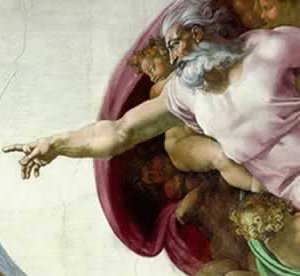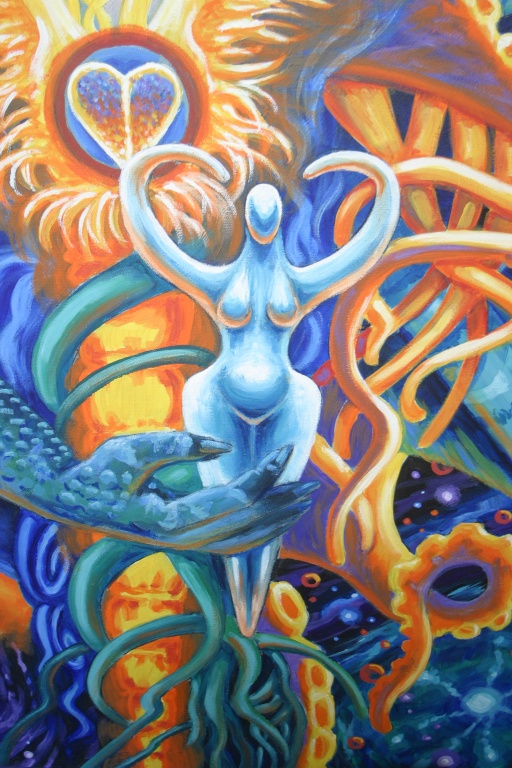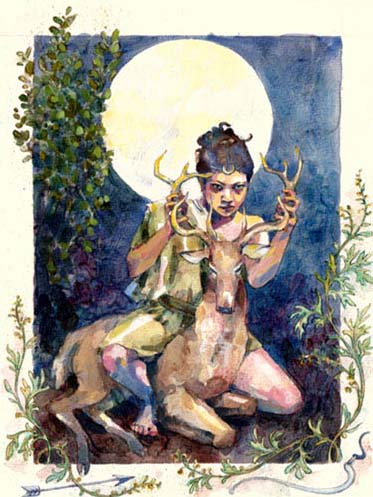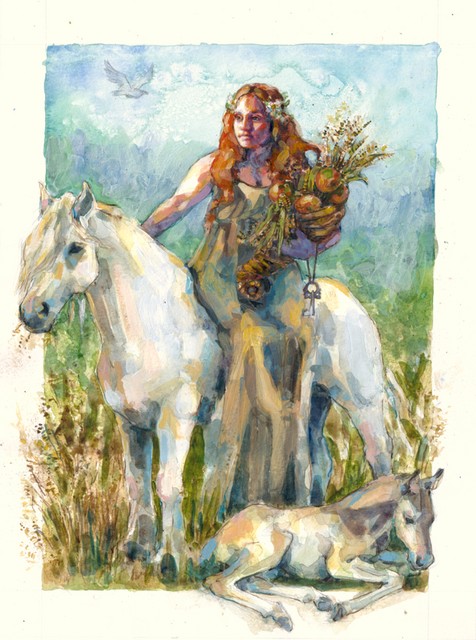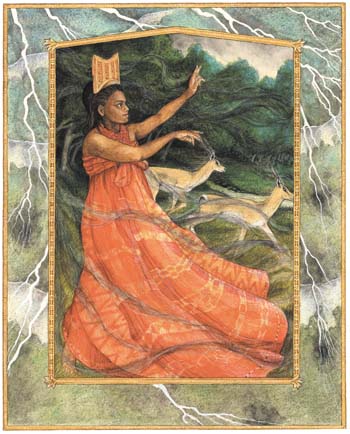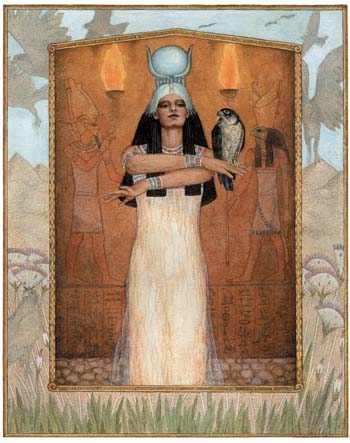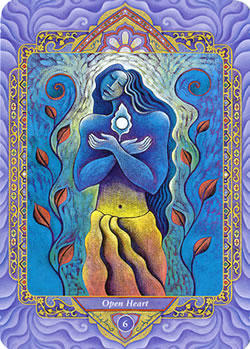Considering that North America’s predominant and founding religion is Christianity, it’s hardly a surprise that the western world’s women suffer from insecurities about not only their bodies, but their emotional and spiritual selves. This is not to suggest that all Christians are patriarchs, women-haters, or anything along those lines; it is simply a fact that Christianity’s archetypes and myths portray women in ill-light.
God from The Creation of Adam (Michelangelo Buonarroti) Christianity’s concept of Deity is male, complete with streaming beard and muscles. The first human created was Adam, who was crafted in the image of God – male. As evidenced by the myth of Adam and Eve, woman was created to please man, created from man, and woman’s weakness was the downfall of humanity. In Christianity’s holy text, the Bible, women are repeatedly treated as subservient, and, over the centuries, have come to represent all that is sinful. Salvation, in the form of Jesus Christ, was male; his holy disciples were also male. People are outraged at the idea of Jesus marrying and having children – it is viewed as lessening his Divinity. Many fundamental Christians believe that women –Eve, for example, or Jezebel, and Delilah – are the root of all evil. Is it any wonder that women raised in a Christian society are taught to hate their bodies, their menses, and their emotions? It should come as no surprise, then, that the way we view Divinity changing in such a way that women no longer feel ashamed of their bodies, of their selves. The concept of Divinity, and the face of religion, is beginning to incorporate women, as popularity shifts from patriarchal Abrahamic religions to more balanced Neo-Pagan religions. Over the past ten years alone, the number of adherents to Paganism and Goddess Worship has grown by 300%. This religious phenomenon is having many positive effects on society, especially with regards to women’s self images – physically, emotionally, and spiritually. Through Goddess Worship, women are raised from inherently filthy and sinful to inherently Divine. This trend, while still dwarfed by Christianity, is slowly helping to create a more egalitarian society in both Canada and the United States.
Thousands of years
ago, when humanity still lived in hunter-gatherer tribes, women were
revered. In primarily gatherer tribes, women were given great respect
and authority. The men were usually hunters, due to the fact that they’re
genetically engineered to be faster and stronger. Women, on the other
hand, gathered plant life, for both medicinal and food purposes. Women
were viewed as powerful; they were fertility goddesses themselves. However,
early hunter-gatherer society was by no means matriarchal – decisions
tended to be made by tribal consensus. In these times, as well as in early agricultural times, the Goddess was seen as an omnipotent, all encompassing figure; She was vague, ethereal, and powerful. The God was present as well; He was seen as the Goddess’ consort. They were equals. As time progressed, the Goddess began to evolve, and adopt various facets. We began to see Divinity shaped into archetypes, in an attempt to create identification and intimate relationships between the worshippers and Deity. Contrary to what many believe, the female Deities were not always mothers, gentle and sweet, nor were the Gods always fighters. They were each unique, with their own personality and myths, not limited by today’s gender stereotypes.
Artemis by Joanna Barnum Today, we’ve seen the reemergence of such Goddess worship. Women have been oppressed for centuries. Christianity – as well as other Abrahamic religions – has been, unfortunately, used as a tool through which men could justify this oppression. However, such an unbalanced approach to life could not sustain itself. Women, as innately powerful as men, began changing their concept of Divine. Underground pockets of Paganism had remained somewhat intact through the centuries; in the mid-twentieth century, a plethora of books swept across North America, all explaining and proclaiming Paganism and Goddess Worship. Many feminists in the sixties embraced a feminine concept of Divinity; they combined their spiritual practices with their politics. For most, it didn’t make sense to be a feminist and still participate in a patriarchal religion. Some branches of Paganism, such as Dianic Wicca, had reacted more extremely to Christianity; they have female-only covens (worship groups) and worship only the Goddess. However, this is certainly not the majority; most Pagans take a more balanced view of Divinity. As Goddess Worship has become more mainstream, it has grown in popularity. An acceptance and reverence for women, and their bodies, was an inevitable ‘side-effect’ of this resurgence.
Epona by Joanna Barnum One of the most
popular creation myths of Wicca, outlined in Starhawk’s book “The
Spiral Dance,” is particularly positive for women’s body
images. In this myth, the Goddess fell in love with Herself, and from
that love She gave birth to the world. The entire world was created
from the Goddess’ Divine love, and is an expression of that love.
Paganism embraces the physical as a valuable experience for the spirit
– all life is sacred, our bodies are sacred, we are beautiful.
A common greeting shared by Pagans is “Thou art God/dess,”
which reaffirms the body and spirit as an expression of Divinity. Nudity is also common in Paganism; as the body is seen as sacred, there is no need to cover it. Many covens practice rituals skyclad (nude), which allows for a deeper connection to nature. By spending time naked, practitioners become more accepting of and comfortable with their bodies. Women, in particular, have always been expected to cover themselves; ritual nudity, in a non-sexual environment, is liberating and invigorating.
Oya by Kris Waldherr In western culture today, menstruation is seen as an unclean, unpleasant fact of life. Comedians, of both genders, joke about pre-menstrual syndrome, and dismiss women by whispering things about “that time of the month.” Menstruation is discussed in derogatory terms. However, in many ancient cultures, menstruation was seen as a sacred and powerful time for women. In villages, most women would menstruate around the same time; they would spend time apart from the men during their menses, not because it was seen as unclean, but because menstruating women were viewed as incredibly powerful. The menstrual energy was potent, and was believed to be too powerful for men to be around. Menstruation was seen as Divine – not only was it a sign of fertility (representative of the Goddess), but also it tied strongly to the Moon, which was a major symbol of the Goddess. The ancient Goddesses that were and still are worshipped are usually categorized into three stages, which are representative of the three stages of a woman’s life – Maiden (pre-menstrual), Mother (menstrual), and Crone (post-menstrual). All aspects are seen as having their own unique powers, and are honored as such.
Isis by Kris Waldherr Although
many Pagans worship vague concepts of God and Goddess, many choose patron
or, more appropriately, matron Deities. Deities are usually pulled from
ancient religions and cultures, such as Norse, Greek, Egyptian, Mayan,
and many more. The archetypes of various Goddesses help women deal with
various aspects of their lives. Artemis, for example, is the Maiden
Moon Goddess; she is a powerful hunter, and independent of men. Her
archetype is used to help women who have been victimized by men. Isis,
an Egyptian Fertility Goddess, uses gentler strength. She helps women
get in touch with their intuition and innate healing abilities. Finally,
Hecate, another Greek Goddess, is an excellent archetype for women who
are making transitions in their life – particularly during menopause.
Hecate is a Crone, and guardian of the crossroads between life, death,
and rebirth. As such, She is a powerful figure for life changes and
transitions. These, and other Goddess figures, allow women to relate
to Divinity; there is a Goddess for every phase of a woman’s life,
a role model for every challenge along the way. Hecate by Sandra Stanton Goddess Worship,
unlike male-centric religions, tells women that they are intrinsically
Divine. Goddesses come in all shapes and sizes. However, beyond the
physical, Paganism teaches that the body, while sacred, is only a vessel
for the soul. It allows women to move beyond their bodies, in a sense,
and realize the Divinity that is within them. They transcend the physical,
while embracing their bodies as a tool for learning. This acknowledgement
of intrinsic Divinity allows women to accept their bodies, along with
their emotions and expressions of self. Goddess Worship and Paganism have had extremely positive impacts on women – the way women view themselves, physically and spiritually, and the ways in which they live their lives. The subjugation of women – physically, emotionally, spiritually – has been going on for centuries. However, with the rise of Goddess Worship, women are able to take back a little of what belongs to all people, regardless of race, religion, sexual orientation, or gender – Divinity.
Open Heart by Mara Friedman |
